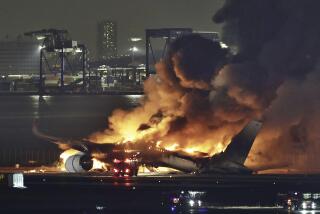1 Engine Shut Down Before Jetliner Crash, British Say
- Share via
LONDON — Investigators have “a pretty clear idea” of what caused last weekend’s crash of a British Midland Airways Boeing 737-400 in central England, but they will not issue a public clarification until after further tests on the aircraft’s engines, government officials said Tuesday.
While the investigators may know what happened, the public was left in even greater confusion following equivocal statements to Parliament and suggestions in the press that pilot error may have been a factor in the crash.
On Monday, officials said that against odds of several million to 1, both engines on the aircraft had apparently failed, causing the plane to come down short of the runway on its approach to an emergency landing.
On Tuesday, Transport Ministry officials said the plane’s starboard, or right side, engine, which had been shut down before the crash, showed no outward evidence of fire or mechanical failure.
There is no doubt that the port, or left, engine caught fire after takeoff, so the question, as the British Broadcasting Corp. put it in its evening newscast Tuesday, is this: “Was the wrong engine shut down?”
Forty-four passengers were killed in the crash and 82 other passengers and crew members were injured. More than 70 were still hospitalized Tuesday, including a dozen in intensive care.
In a statement to the House of Commons on Tuesday, Transport Minister Paul Channon said that British Midland’s Belfast-bound Flight 092 encountered trouble soon after leaving London’s Heathrow Airport.
“About 15 minutes into the flight, the pilot reported a fire in the starboard engine,” he said. “The fire was apparently successfully dealt with and the captain asked for permission to divert to East Midlands Airport for an emergency landing.
“Eyewitnesses report that during the final approach to East Midlands Airport, the aircraft descended below the normal path with the engine, or engines, making unusual noises. The aircraft crashed just short of the airport. . . .”
Investigators of the Air Accident Branch later “found evidence consistent with a shutdown in flight of the right engine before impact and evidence of a fire in the left engine,” Channon told the House of Commons.
Earlier, however, Chief Investigator Ed Trimble told reporters that “we have no evidence at the moment of a mechanical failure in the right engine.” Neither, he said, was there any sign of fire damage to that engine. Nevertheless, he confirmed that “that engine was shut down before the aircraft crashed.”
When questioned by an Independent Television News interviewer about the apparent conflict between his chief investigator’s comments and his own statement about the report of a fire in the right engine, Channon responded, “I’m certainly not going to contradict him.”
Further confusing the situation were conflicting statements by survivors about which engine they saw on fire, and which one they heard pilot Kevin Hunt say he was shutting down.
Some aviation experts dismissed suggestions that Hunt might have responded to a cabin alarm signaling a fire in the left engine by accidentally shutting down the right engine. The alarm presumably would have continued sounding until he corrected his mistake.
Nevertheless, a Transport Ministry spokesman said Tuesday night that pilot error is “obviously one of the theories being batted about” in speculation over the cause of the accident.
“We’re keeping all options open,” the spokesman said.
Investigators have already checked the cockpit voice recorder and the flight data recorder from the British Midland plane. On Tuesday, they began removing the wreckage, including the engines, from the scene of the crash.
‘Strip Examination’
Trimble said investigators will conduct “a strip examination of both engines” before reaching any firm conclusions, although “I think we have a pretty clear idea at this stage” of what caused the crash.
Investigators questioned pilot Hunt in the hospital, but they refused any public statement on his remarks. Hunt is at least temporarily paralyzed with spinal injuries. He has been praised by survivors and residents of a small town near the crash for managing to maneuver his stricken aircraft away from the village, thereby avoiding a more devastating accident.
In a related development Tuesday, Transport Minister Channon told the House of Commons that a bomb that brought down Pan American Airways Flight 103 over southern Scotland on Dec. 21, killing 270 people, was placed in the forward cargo and baggage hold, just forward of the wing.
He said it has still not been determined how or where the bomb was smuggled on board, or by whom, and he added:
“The signs of the use of a high-performance plastic explosive, which was very probably but not certainly Semtex, point to some well-organized and well-supplied terrorist group.”
Semtex is an almost colorless and odorless explosive produced in Czechoslovakia. The Czechoslovak government has told Britain that the product is no longer exported. But previous sales include large amounts to Libya.
More to Read
Sign up for Essential California
The most important California stories and recommendations in your inbox every morning.
You may occasionally receive promotional content from the Los Angeles Times.










